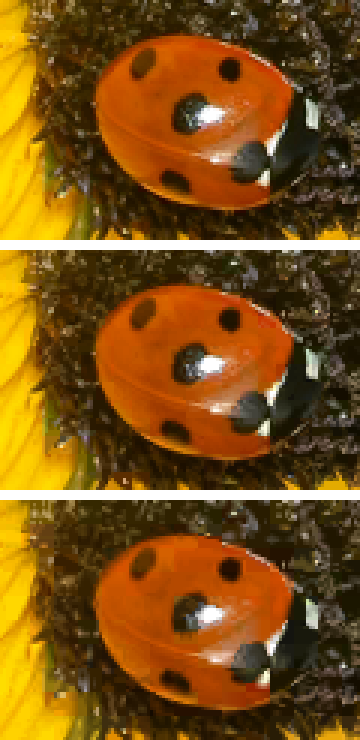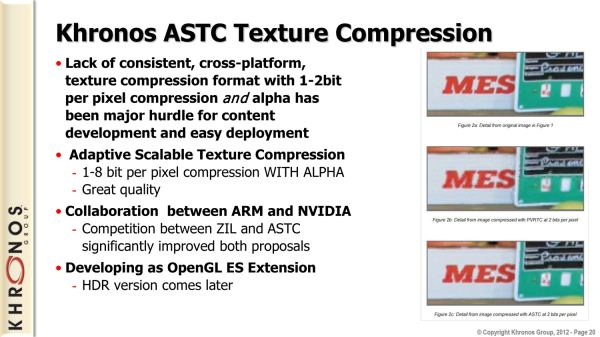Khronos Announces OpenGL ES 3.0, OpenGL 4.3, ASTC Texture Compression, & CLU
by Ryan Smith on August 6, 2012 9:00 AM ESTAdaptive Scalable Texture Compression
As we’ve noted in our rundowns of OpenGL and OpenGL ES, the inclusion of ETC texture compression support as part of the core OpenGL standards has finally given OpenGL a standard texture compression format after a number of years. At the same time however, the ETC format itself is approaching several years old, and not unlike S3TC it’s only designed for a limited number of cases. So while Khronos has ETC right now, in the future they want better texture compression and are now taking the first steps to make that happen.
The reward at the end of that quest is Adaptive Scalable Texture Compression (ASTC), a new texture compression format first introduced by ARM in late in 2011. ASTC was the winning proposal in Khronos's search for a next-generation texture compression format, with the ARM/AMD bloc beating out NVIDIA and their ZIL proposal.
As the winning proposal in that search, if all goes according to plan ASTC will eventually become OpenGL and OpenGL ES’s mandatory next generation texture compression algorithm. In the meantime Khronos is introducing it as an optional feature of OpenGL ES 3.0 and OpenGL 4.3 in order to solicit feedback from hardware and software developers. Only once all parties are satisfied with ASTC to the point that it’s ready to be implemented into hardware can it meaningfully be moved into the core OpenGL specifications.
So what makes ASTC next-generation anyhow? Since the introduction of S3TC in the 90s, various parties have been attempting to improve on texture compression with limited results. In the Direct3D world where S3TC is standard, we’ve seen Microsoft add specialized formats for normal maps and other texture types that are not color maps, but only relatively recently did they add another color map compression method with BC7. BC7 in turn is a high quality but lower compression ratio algorithm that solves the gradient issues S3TC faces, but for a 24bit RGB texture it’s only a 3:1 compression ratio versus 6:1 for S3TC (32bit RGBA fares better; both are 4:1).


ASTC Image Quality Comparison: Original, 4x4 (8bpp), 6x6 (3.56bpp), & 8x8 (2bpp) block size
Meanwhile in the mobile space we’ve seen the industry’s respective GPU manufacturers create their own texture compression formats to get around the fact that S3TC is not royalty free (and as such can’t be included in OpenGL). And while Imagination Technologies in particular has an interesting method in PVRTC that unlike the other formats is not block based – and thereby can offer a 2bpp (16:1) compression ratio – it has its own pros and cons. Then of course there’s the matter trying to convince holders of these compression methods to freely license them for inclusion in OpenGL, when S3/VIA has over the years made a tidy profit off of S3TC’s inclusion in Direct3D.
The end result is that the industry is ripe for a royalty free next generation texture compression format, and ARM + NVIDIA intend to deliver on that with the backing of Khronos.
While ASTC is another block based texture compression format, it does have some very interesting functionality that pushes it beyond S3TC or any other previous texture compression format. ASTC’s primary trick is that unlike other block based texture compression formats, it is not based around a fixed size 4x4 texel block. Rather ASTC has a fixed size of 128bits (16 bytes) with a variable size block ranging from 4x4 to 12x12, in effect offering RGBA compression ratios from 8bpp (4:1) all the way up to an incredible 0.89bpp (36:1). The larger block size not only allows for higher compression ratios, but it also offers developers a much finer grained range of compression ratios to work with compared to previous texture compression formats.
| Block Size | Bits Per Px | Comp. Ratio |
| 4x4 | 8.00 | 4:1 |
| 5x4 | 6.40 | 5:1 |
| 5x5 | 5.12 | 6.25:1 |
| 6x5 | 4.27 | 7.5:1 |
| 6x6 | 3.56 | 9:1 |
| 8x5 | 3.20 | 10:1 |
| 8x6 | 2.67 | 12:1 |
| 10x5 | 2.56 | 12.5:1 |
| 10x6 | 2.13 | 15:1 |
| 8x8 | 2.00 | 16:1 |
| 10x8 | 1.60 | 20:1 |
| 10x10 | 1.28 | 25:1 |
| 12x10 | 1.07 | 30:1 |
| 12x12 | 0.89 | 36:1 |
Alongside a wide range of compression ratios for traditional color maps, ASTC would also support additional types of textures. With support for normal maps ASTC would also replace other texture compression formats as the preferred format for normal maps, and it would also be the first texture compression format with support for 3D textures. Even HDR textures are on the table, though for the time being Khronos is starting with only support for regular (LDR) textures. With any luck, ASTC will become the all-uses texture compression format for OpenGL.
As you can imagine, Khronos is rather excited about the potential for ASTC. With their strong position in the mobile graphics space they need to provide paths to improving mobile graphics quality and performance amidst the reality of Moore’s Law and the other realities of SoC manufacturing. Specifically, mobile GPU bandwidth isn’t expected to grow by leaps and bounds like shading performance, meaning Khronos and its members need to do more with what amounts to less memory bandwidth. For Khronos texture compression is key, as ASTC will allow developers to pack in smaller textures and/or improve their texture quality without using larger textures, thereby making the most of the limited memory bandwidth available.
Of course the desktop world also stands to benefit. ARM’s objective PSNR data for ASTC has it performing far better than S3TC at the same compression ratio, which would bring higher quality texture compression to the desktop at the same texture size. And since ASTC is being developed by Khronos members and released royalty free, at this point there’s no reason to believe that Direct3D couldn’t adopt it in the future, especially since all major Direct3D GPUs also support OpenGL in the first place, so the requisite hardware would already be in place.
With all of that said, there’s still quite a bit of a distance to go between where ASTC is at today and where Khronos would like it to end up. For the time being ASTC needs to prove itself as an optional extension, so that GPU vendors are willing to implement it in hardware. It’s only after it becomes a hardware feature that ASTC can be widely adopted by developers.











46 Comments
View All Comments
djgandy - Tuesday, August 7, 2012 - link
I agree, I did say 'like apple' though, but yes, no one is really interested in desktop GL anymore.At least apple went 3.2 core though and explicitly state in their documentation that deprecated features are removed
https://developer.apple.com/library/mac/#documenta...
Tessellation (Burning energy) aside I don't think there are many headline features that desperately need adding from 4.0 onwards. Apple did only support 2.1 until they released 3.2 support!
Jumangi - Monday, August 6, 2012 - link
Yea DX isn't the stagnated one. OpenGL is a spec has been behind DirectX for years now. The stagnation is from allot of developers who don't use the latest stuff since they stay with the lowest denominator we still have with the PS3 and 360. The features are there if developers want to use them.sheh - Monday, August 6, 2012 - link
And WinXP.ltcommanderdata - Monday, August 6, 2012 - link
It's mentioned in the article that nVidia desktop GPUs don't support ETC in hardware. Do we know whether ETC support in hardware is universal across OpenGL ES 2.0 GPUs from various vendors like PowerVR, ARM, Qualcomm, and nVidia? In the transition, games will no doubt include both OpenGL ES 2.0 and 3.0 render paths to support more devices, and it'd be preferable if both paths could share texture assets.Since ASTC is optional right now which GPU makers have announced they support it in hardware?
It'll be interesting to see what Apple does with ETC on iOS. The existing PVRTC is more efficient on PowerVR GPUs than ETC. I can't see Apple happy to support a less efficient texture format whose benefit to developers but not Apple is to ease portability of games to Android. I suppose Apple will enable ETC support for compatibility, but won't be investing effort in optimizing it's performance. IMG just released a new PVRTC2 texture format for Series5XT and Series6 GPU that improves upon PVRTC, so I expect Apple will be pushing that format soon on iOS.
Ryan Smith - Monday, August 6, 2012 - link
Most current OpenGL ES 2.0 GPUs do not support ETC. I do not have a good list, but I know that PowerVR, Tegra, and Adreno do not support it. So until OpenGL ES 3.0 is the baseline, developers will still have to deal with disjoint texture compression formats. But at least there's finally a way out.As for ASTC, none of the GPU vendors have announced that they'll be supporting it in hardware. This is part of the reason why ASTC is currently being floated as an extension, in order to gather feedback. Now that the standard is out, GPU vendors can look at integrating hardware support. Since this is a joint ARM/NV proposal, I'd expect both of them to integrate support a the earliest opportunity.
pebrb - Monday, August 6, 2012 - link
You are confusing ETC and ETC2 in the entire article.All current OpenGL ES 2.0 GPUs _do_ support ETC (not ETC2) as it is the standard in ES 2.0
The only vendor that doesn't support it is Apple (even though the PowerVS SGX has support for it)
The reason for developers support different texture formats is because ETC is very low quality and lack of alpha channel support.
In OpenGL ES 3.0 they made ETC2 the standard, we'll see how it'll work out.
But I'm waiting for ASTC it has very good features. And from what I heard it will be supported by Microsoft as well, which means that everyone needs to implement it anyway.
name99 - Monday, August 6, 2012 - link
"I can't see Apple happy to support a less efficient texture format whose benefit to developers but not Apple is to ease portability of games to Android."Is any of this conspiracy theory in the slightest grounded in reality?
Apple has generally been happy to support standards, even when that's not directly relevant to its goals. The web world (HTML5 and h264) are obvious examples, but an example more relevant to what we're discussing here is Apple's aggressive support for C++11 (both language and library) in the latest version of XCode. And this is not just passive checkbox support, it is genuine hard work to make C++11 interoperate well with Objective C, and to perform well.
ltcommanderdata - Monday, August 6, 2012 - link
My doubt isn't about Apple supporting standards in general, it's about them supporting a weaker technology as a standard. Apple promotes H.264 over WebM, because it has superior image quality (yes there is some debate) and superior hardware support. With the existing PVRTC texture format on iOS offering better performance and image quality than ETC on the GPUs Apple uses I can't see them singing ETC's praises as a standard. They'll no doubt add iOS support for ETC as it's required for OpenGL ES 3.0, but I don't doubt they'll be strongly encouraging iOS developers to keep using PVRTC and soon PVRTC2.Alexvrb - Monday, August 6, 2012 - link
PVRTC2 will likely wipe the floor with ETC2. Heck it'll probably be better than ASTC too.iwodo - Tuesday, August 7, 2012 - link
Would love to see PVRTC2 Vs ASTC